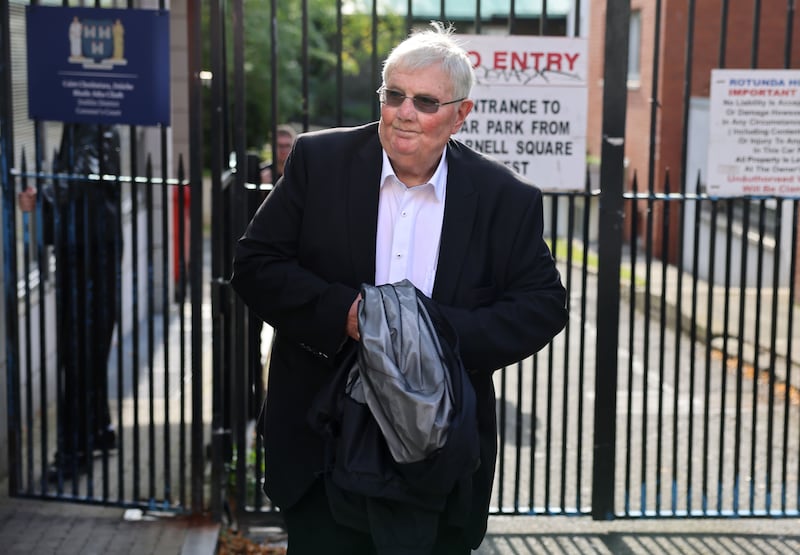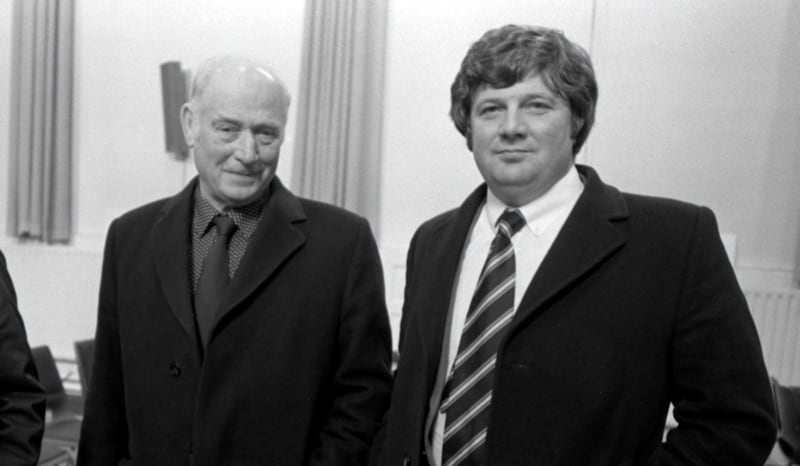Eamon Butterly (78), former manager of the Stardust nightclub in north Dublin in which 48 people died in a fire in February 1981, has insisted he instructed doormen not to lock emergency exits.
In direct evidence to Dublin coroner’s court on Thursday, he appeared to contradict Garda statements he made in the aftermath of the blaze, in which he said a policy of leaving doors locked until as late at 11.30pm on disco nights had been introduced a few weeks before the disaster.
This had been “forced on me by the fact that a large number of people were getting in free due to the actions of their friends who were opening exit doors from the inside”, he said in 1981.
On Thursday, however, he said exits 2, 3 and 4 were unlocked before 10pm.
READ MORE
He said when head doorman, the late Thoman Kennan, told him exits 5, 6 and 1 were being kept locked until later in the night, he told him not to do this.
“Tom Kennan told me, but I didn’t see them locked. I told him not to have them locked,” he said.
“So you never saw any exit door locked in the Stardust?,” asked Gemma McLoughlin-Burke, BL, for the inquests.
“No, and if I did there would be trouble,” said Mr Butterly.
Ms McLoughlin-Burke asked how this fit with his 1981 statement that there was a policy of locking exits until 11.30pm or midnight, and if this was “normal practice” as his statement indicated.
“Until I found out and told them to stop doing it,” said Mr Butterly. “[I told him] he had to stop doing it ... If he was doing it. I didn’t know it. I told him to stop.”
“What efforts did you make sure he was no longer ... locking those doors while there were people inside?” asked Ms McLoughlin-Burke.
“Well, I trusted him.”
Mr Butterly’s appearance at the inquests provides his first public commentary on the disaster in over four decades. Fresh inquests are under way into the deaths of 48 young people in a blaze at the club in the early hours of February 14th, 1981.
He appeared relaxed and, with the assistance of an audio-amplifying headset, answered questions from counsel confidently.
Ms McLoughlin Burke put evidence to him, already heard from other witnesses, that exit 5 was regularly blocked, by at least one bottle-skip.
He said he told general manager Brian Peel “that shouldn’t happen and he assured me he would make sure it didn’t happen”.
He was aware DJs parked their van right up against exit 3, to bring equipment in, and said he told the DJs not to. “Did you take other steps to ensure that didn’t happen,” such as asking doormen to enforce this, asked Ms McLoughlin-Burke. “I think the doormen told them as well, many times.”

Mark Tottenham, BL, for the inquests, asked Mr Butterly about the decision to place metal sheets over the toilet windows “a while before” the fire.
“The doormen were complaining all the time of people passing stuff through windows. They were only tiny windows. They were breaking the glass ... passing in weapons and stuff like that.
“My father, he was getting annoyed and said, ‘We have to do something about it’.”
He said the decision was made jointly by him, his late father, Stardust owner Patrick Butterly and Mr Kennan. There was no discussion with the local authority about it, he said.
Asked if there was discussion about the impact on evacuating the building, he said: “You couldn’t get out through them. They were tiny ... and the frame were made of steel.”
“Did you ever consider any alternatives to steel sheets, such as fine-mesh sheets?” asked Mr Tottenham.
“No.”
“Did you ever consider putting in some kind of emergency release ... like a key.”
“No ... but they weren’t a means of escape ... Most toilets had no windows at all.”
Asked about the decisions to use flammable carpet-tiles to line internal walls, Mr Butterly said he had believed a fire safety certificate provided to the local authority, Dublin Corporation, had been sufficient and that the tiles were safe.
“As far as I was concerned if Dublin Corporation said the carpet tiles couldn’t go on the wall they wouldn’t go on the wall. They accepted the certificate ... and didn’t say that. The carpet tiles went on the wall and everybody that was there liked them.”
Mr Tottenham asked if he had been aware of 1967 Fire Protection Standards for people “who should be responsible for fire safety”. He was not and they were never drawn to his attention by Dublin Corporation.
There was no discussion about appointing a fire-officer among the staff, or drawing up a fire-plan, firefighting training, as required in the standards.
Mr Butterly resumes his evidence on Friday.
Original statements
In his 1981 Garda statements, read into the record on Thursday morning, Mr Butterly said 815 people attended the Stardust nightclub on the night of the fire.
The inquests have heard the blaze was first seen on a bank of seats at the back of a partitioned area known as the West alcove at about 1.40am. It quickly spread up carpet-tiled walls, shooting across a low-hung ceiling and engulfing the entire venue in about four minutes.
Describing the fire, Mr Butterly said in his statement: “I was amazed to see here where the fire was as this area had been partitioned off since last Sunday and the Stardust itself had not been used since that day.
“I saw that the fire extinguishers were not putting out the fire and I shouted at the men to concentrate on getting the people out of the premises.”
He continued: “I then endeavoured as best I could with staff to raise the alarm and clear the building. As the smoke got progressively thicker I realised that I must leave the premises and I did so via the Silver Swan bar through a connecting door.”
He said he saw people “pouring” out the front exits and doormen “pulling people out through the exits”.
“I would like to add that in accordance with normal procedures I asked Tom Kennan, the head doorman, if all the fire exits were unlocked and he answered me that they were and that he had men stationed at each exit in accordance with standard procedure.

“I personally saw that 10 of the exits were opened and Tom Keenan then went over to the other exits himself and came back to me and said everything was OK. This occurred between 11pm and 11.30pm,” he told gardaí in 1981.
He said a policy of leaving doors locked until as late at 11.30pm on disco nights had been introduced a few weeks before the disaster. This had been “forced on me by the fact that a large number of people were getting in free due to the actions of their friends who were opening exit doors from the inside,” he said.
Metal grating had been put over toilet windows at the front of the building about three weeks before the blaze, he said. The inquests have heard metal plates and vertical bars were placed over the windows about six weeks before, and descriptions of people screaming at these windows as the fire swept through the building.
“It was necessary because of the following reasons,” said Mr Butterly in 1981. “Patrons in the premises were going into the toilets and their friends outside were breaking the toilet windows and passing in weapons such as knives, hatchets and iron bars. This practice referred to above arose mainly out of the strict searching of the patrons which had been ordered by me in the preceding weeks.
“On Sunday nights between the hours of 10pm and 12am patrons were going into the toilets and their friends outside were passing in bottles of intoxicating liquor.”
A policy of draping chains over emergency exit push-bars had “originated” with the doormen, Mr Butterly told gardaí. “They had used this practice in other places where they worked. I did not order them to do this, but I was aware of the practice, and did not stop same”.
He was asked what actions staff were to take in the event of a fire. “No specific instructions were given to the staff in the event of a fire. I felt that as I was not an expert that I would not be aware of what specific instructions should be given to the staff in the event of a fire ... To the best of my knowledge no special training was given to the doormen,” he said.
Asked if the question of fire was ever discussed by management, he said it was “never discussed” with the doormen but was with the kitchen manageress. He “assumed ... an immediate phone call to the fire brigade that the fire brigade would arrive in time to deal with any fire”.
He added no fire officer had attended the building during its conversion, from a food factory to an entertainment venue, between 1977 and 1978.
He said he believed the fire had been started deliberately for several reasons. “The fact that I saw the seats were burning in a straight line and that the flames were running along the top of the said seats; the fact that there was no electrical apparatus in the partitioned off area except the lights in the ceiling which were still operating normally when seen by me at the time of the fire; [the fact] that there had been no shows in the Stardust since the previous Sunday.
He continued: “[The fact] that the fire was first seen up at the back of the tiered area where nobody would have needed to go; the statement of [doorman] PJ Murphy that morning to me in which he said that a girl had come over to him at the door and said, ‘They are after starting a fire in the corner’, and, the history of previous false alarms in the previous weeks in which the location of the fire was stated to be in the curtained off area. “.
The 1981 finding, by Mr Justice Ronan Keane who chaired a tribunal of inquiry into the fire, that the “probable” cause of the fire was arson, was removed from the public record by the Houses of the Oireachtas in 2009.
The statements from Mr Butterly included his account of efforts he made to comply with building regulations during the conversion of a former food factory at Kilmore Road, Artane, into the Stardust venue between 1976 and 1978.













